 Customers’ prosperity is your path to prosperity. For your solutions serving their needs, their funding serves the needs of employees, partners, and investors. Inversely, customers’ hardships (lack of prosperity) are extra costs for you, either to resolve their issues or to expand sales with new customers. As two sides of a coin, customers’ funding and costs dictate your top-line and bottom-line growth.
Customers’ prosperity is your path to prosperity. For your solutions serving their needs, their funding serves the needs of employees, partners, and investors. Inversely, customers’ hardships (lack of prosperity) are extra costs for you, either to resolve their issues or to expand sales with new customers. As two sides of a coin, customers’ funding and costs dictate your top-line and bottom-line growth.
As you approach 2024, switch now to the 24 CX metrics listed below. Use this dashboard for your Chief Customer Officer Prosperity Playbook. Then you’ll see impressive, sustained top-line and bottom-line growth.
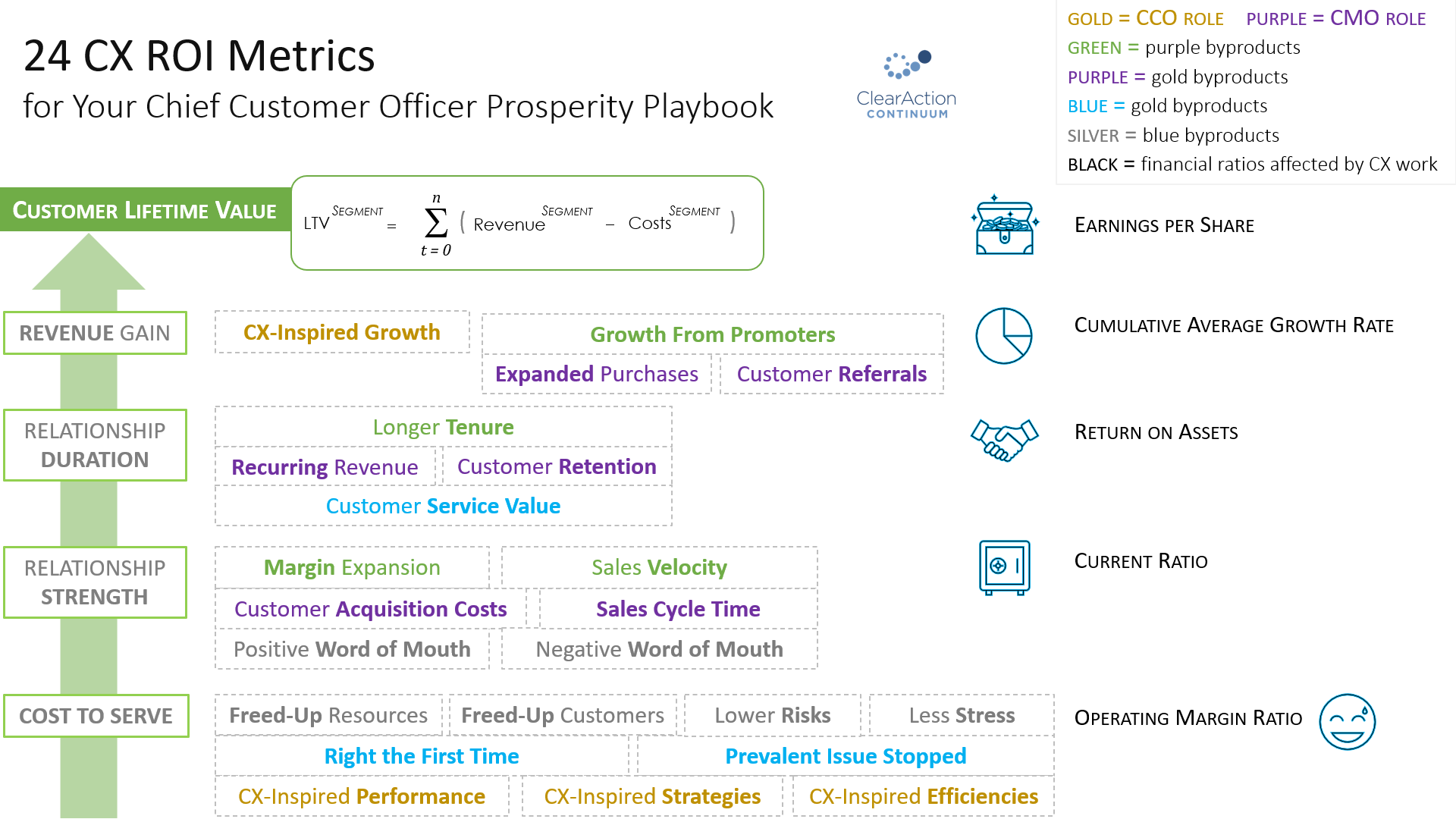
Speak in executives’ language: money. These CX metrics are expressed in currency. All other metrics you track are a subset of these currency metrics. What matters is the money spent versus the money generated (also known as return on investment [ROI]). (Not listed in any particular order. Your fine-tuning of these equations is welcome in the comments.)
Top-Line CX Metrics
1. Customer Referrals: Percent Promoters times Number of Customers times Product Price.
2. Expanded Purchases: Number of Customers Retained times [Their Purchases Now minus Their Purchases Before].
3. Longer Customer Tenure: Product Price times Purchase Frequency times [Tenure Now minus Tenure Before].
4. More Positive Word of Mouth: Product Price times Recommendation Frequency times [Percent Promoters Now minus Percent Promoters Before].
5. Growth from Promoters: Customer Referrals plus Expanded Purchases plus Longer Customer Tenure plus More Positive Word of Mouth.
6. CX-Inspired Growth: Number of Transactions from New Growth Efforts times [Margin of CX-Inspired Efforts minus Margin of Internally Inspired Efforts].
(new growth efforts = market expansion, new products, business models, partnerships etc.)
7. Recurring Revenue (Monthly, Annually, Net): Active Users times Product Price.
8. Margin Expansion: Margin Now minus Margin Before.
9. Sales Velocity: [Number of Sales Opportunities times Product Price (or Average Deal Size) times Win Rate Percentage] divided by Sales Cycle Length.
Note: for accuracy in top-line CX metrics, you will need to research your customers’ behaviors:
- Do Promoters recommend other brands alongside your brand?
- How often do Promoters recommend?
- Do Promoters recommend high-price or low-price products? (or high or low margin)
- Do Promoters recommend to high-volume or low-volume buyers?
- How many Promoters are high-volume buyers?
- Is word-of-mouth behavior of Promoters equal to behavior of Detractors?
- How often do Detractors complain to others?
- How is Detractor behavior swaying potential buyers from buying?
Your ultimate goal is maximum lifetime value. All CS and CX metrics and measures are a subset of lifetime value. You will see bigger gains faster with bottom-line CX metrics. Botom-line efforts bless all existing and future customers and your growth from them.
Focus executives’ attention first on bottom-line metrics. Bottom-line CX metrics have sustained advantages. Do it once and benefit for many years. Most importantly, bottom-line CX metrics also improve customer prosperity, which helps them grow your prosperity. Therefore, every gain in bottom-line CX metrics translates to higher gains in top-line CX metrics.
Prevalent Issue Stopped has gigantic potential because it has a domino effect on Freed-Up Resources, Freed-Up Customers, and Lower Risks.
Bottom-Line CX Metrics
10. Lower Customer Acquisition Cost: Customer Acquisition Cost Before minus Customer Acquisition Cost Now.
(customer acquisition cost = [all sales and marketing salaries and fringe benefits plus overhead plus paid marketing plus marketing and sales tools] divided by number of new customers.)
11. Customer Lifetime Value: Typical Length of Customer Relationship times {Revenue minus [Customer Acquisition Cost plus All Customer Success Costs plus All Customer Service Costs plus All Loyalty Program Costs]}.
12. Customer Service Value: Product Price times Number of Customers Whose Request for Help Started Tensely Yet Ended Calmly.
13. Customer Retention: [All Customer Success Costs plus All Customer Service Costs plus All Loyalty Program Costs] divided by Number of Retained Customers.
14. Less Negative Word of Mouth: Percent Detractors times Number of Customers times Customer Acquisition Cost.
15. Less Workplace Stress: [Hourly Sum of: Average Salary plus Average Fringe Benefits] times [Productivity Now minus Productivity Before].
16. Shorter Sales Cycle Time: Customer Acquisition Cost divided by [Sales Cycle Time Now minus Sales Cycle Time Before].
17. Right the First Time in Product Design, Go to Market, etc.: New Product Margin times [Cost to Serve Old Product minus Cost to Serve New Product].
(cost to serve = returns plus credits plus discounts plus incentives plus remedies plus escalations plus negative word of mouth’s effect on customer acquisition cost plus churn.)
18. Prevalent Issue Stopped: {[Hours per Year Resolving Instances of This Issue times [Hourly Sum of: Average Salary plus Average Fringe Benefits plus Average Technology Seat Costs]} plus [Returns plus Credits plus Discounts plus Incentives plus Remedies plus Escalations plus Negative Word of Mouth’s Effect on Customer Acquisition Cost plus Churn] minus Cost to Stop Issue Recurrence at Root Cause.
19. Freed-Up Resources: New Advantages Generated by Former Value-Rescuing Resources That Are Now Redeployed to Value-Creating Efforts.
(new advantages = patents, new products, new markets, bigger and happier workforce, etc.)
20. Freed-Up Customers: New Advantages Generated by Customer Productivity plus Removal of Inhibitions to Recommend Your Brand Whole-Heartedly.
(customer productivity = their time, resources, and results. For instance, if customers’ salespeople are tied up with your value-rescuing processes, they’re not selling as much as they could, and therefore, buying more from you via the demand they generate. If consumers are tied up with your processes, their quality of life is lower: time for family, eating right, exercising, etc.)
21. Lower Risks Due to Freed-Up Resources: [Hourly Sum of: Average Salary & Fringe] times Time Spent Last Year Managing Escalations, Skimpflation, Inflation, Layoffs, etc.
(estimate hours for all the meetings, correspondence, and work-arounds you spent time on for these risks.)
Or Competitive Value of Maintaining Lower Price per Quantity While Competitors Cannot Match It.
(competitive value = their customers switching to your brand, and your existing customers staying with your brand, etc.)
22. CX-Inspired Efficiency: Savings from Efficiencies Using CX Insights minus Savings from Efficiencies Not Using CX Insights.
23. CX-Inspired Performance: Productivity of Groups Using CX Insights minus Productivity of Groups Not Using CX Insights.
24. CX-Inspired Strategies for all work groups enterprise-wide: Hourly Average Salary & Fringe times [Hours This Year in Realignment Communications minus Hours Last Year in Realignment Communications].
(realignment = someone dropped the ball, mis-matched agendas, sloppy execution.)
Be transparent with your audience about the source of your data and its limitations. Use whatever data you have easy access to, with estimations and extrapolations. Tell them, “These are the puzzle pieces we could readily access, for illustration purposes” and “Of course, this is the tip of the iceberg”. Experiment with this technique boldly yet humbly, and you’ll gain confidence in it.
Your Chief Customer Officer Playbook
 Business success is meeting or exceeding expectations — of investors, customers, partners, and employees. Whenever performance is below expectations, it costs you in opportunities or resources. Poor experience robs investors of potential top-line and bottom-line growth.
Business success is meeting or exceeding expectations — of investors, customers, partners, and employees. Whenever performance is below expectations, it costs you in opportunities or resources. Poor experience robs investors of potential top-line and bottom-line growth.
- Say what they’ll get and deliver what you say. This is brand integrity. A 1-to-1 ratio (or better) between what’s received versus expected minimizes waste and maximizes growth. This is true worldwide for discount brands, luxury brands, government, non-profits, etc. (aka enterprises, “brands”).
- Brand integrity is what matters most to customers and employees. When realities match their expectations across their end-to-end life cycle, there’s no need for remedial costs.
- Issue-free experiences generate uninhibited recommendations, engagement, purchase expansion, retention, productivity, and lifetime value. Mistake-proofed performance has a magnetic attraction to new and existing customers, employees, partners, and investors.
Who is championing brand integrity in your enterprise?
- CX leader focus is outside-in enterprise-wide for issue-free performance, whereas CS leader focus is customer touchpoints, primarily to make up for sloppy management. CSM is a subset of CXM, which is customer-centered management. [See Part 1 of 5: Chief Customer Officer Playbook: Balancing Experience Leadership with Experience Management]
- The CX Leader is a brand integrity officer, most often known as Chief Customer Officer. You can call the CCO role brand integrity, risk reduction, value maximization, or any other exciting name.
- Let customer-facing groups report wherever it’s most natural in your company. Dotted-line reporting to the CCO is sufficient. Otherwise, when every customer management function reports to the CCO, customer-centricity tends to be lower. Non-customer-facing work groups tend to think falsely: “That other group covers customer experience. It has nothing to do with me.”
- To mistake-proof performance, collect Expectations VoC and share it in timely, tailored, actionable and compelling ways with everyone.
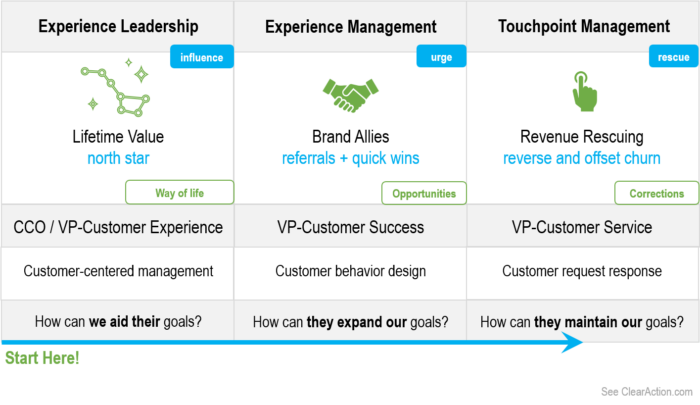

To drive the highest growth, here’s the Chief Customer Officer Playbook:
A. CX-Inspired Growth
- Establish a lifetime value mindset enterprise-wide. When you show them how much of their potential budget is being squandered by their missteps, their response is “That can’t stand! What can we do about this?”. Aim for this reaction in every CX/EX report you share.
- Champion customer insights as the basis for every growth endeavor: new products, new markets, business models, targeting customer segments, etc.
- Ensure realistic expectations in customer acquisition.
- Emphasize lifetime value in customer engagement efforts.

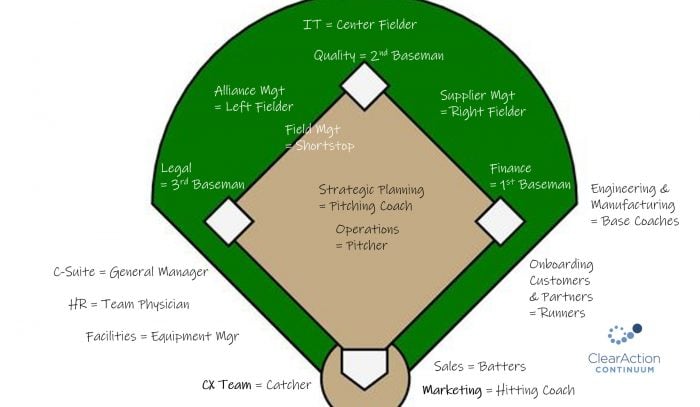
B. CX-Inspired Performance
- Infuse customer insights and criteria into every work group’s performance standards. Translate insights to each work group’s care-abouts and jargon for maximum relevance and resonance. There’s no need for them to learn CX scales, formulas, etc. They just need to know what to DO about gaps and opportunities.
- Establish the business context for every employee’s purpose, i.e. their effect on gaps in what’s received versus promised to customers who make their salaries and budgets possible. Most employees want their work to shape the future in a meaningful way, according to the Trust at Work study by Edelman (September 2023). [See Part 4 of 5: How to Thrill Investors with Your CCO Leadership Playbook]
- Guide managers in connecting customer outcomes to business outcomes at every opportunity.
- Embed CX stories and criteria (especially: what are you doing to close/prevent gaps?) in all types of reviews, approvals, agendas, templates, recognition, development, compensation, succession, etc.
C. CX-Inspired Strategies
- Coordinate value communicated by Marketing and Sales, fulfilled by Service Delivery and Logistics and partners, rescued by Service Recovery, and created primarily by all non-customer-facing groups and suppliers. [See Part 2 of 5: CCO Strategy: Dispensable Playbook or Most Valuable Player?]
- Empower strategic planning to consider customers’ views first about your opportunities and threats, and strengths and weaknesses.
- Make intentional customer experience the North Star for everyone’s decisions.
- Facilitate customer-centered strategic plans of every group to convert costs, embolden expansions, and straighten strategies.
- Facilitate cross-organizational collaboration to overcome silos. Silo-smoothing is your CX Council’s top mission.
D. CX-Inspired Efficiencies
- Champion customer insights as the basis for every efficiency endeavor: re-engineering a process or organization, containing costs, etc.
- Stop root causes of brand integrity gaps. This frees up precious value-rescuing budget that could otherwise fund value-creating. Freed-up budget can be reallocated to expanded capabilities and opportunities, salary and bonus increases, and higher profit-sharing.
- Outer loop VoC is where the huge CXM ROI is. It’s the foundation of lifetime value. Bonus: The outer loop seeps customer focus into all levels and departments of your company.
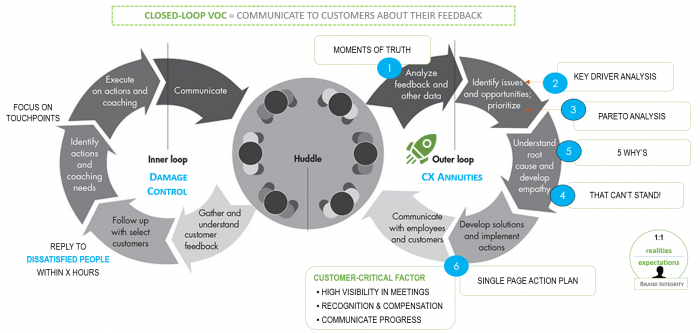
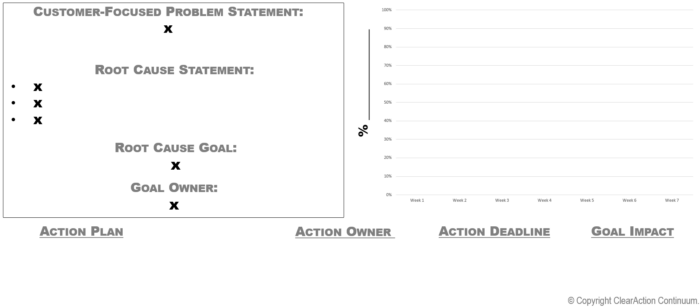
- Facilitate urgency in acting on insights. “In the majority of firms, nothing is being done with that data. Actions do not line up with the employee surveys. This is where we have failed as leaders,” says Tiffany Bova, author of The Experience Mindset: Changing the Way You Think about Growth. Give every group their report and guide each group in discovering root causes for the top 2 issues in their report. Facilitate their single-page action plan to stop the root causes forever.
- Ensure accountability in the closure of action plans. Give high visibility to Gantt charts, swim lane diagrams, RACI (role, action, communicate, inform) charts, and single-page strategies. Get them at the top of meeting agendas. Really, what’s more important than making it easier for your customers to give you more money? (and cost you less!) That’s what CX/EX accountability is all about: permanently removing pebbles from all customers’ shoes and all employees’ shoes.
Be bold this year to implement something in the Operationalize, Align, and Embed levels of the CX maturity model — in tandem. This is urgent for everyone — whether starting for the first time or revising a long-standing CX strategy. [See Part 3 of 5: 3 Ironic Success Factors for Your CCO Maturity Playbook]
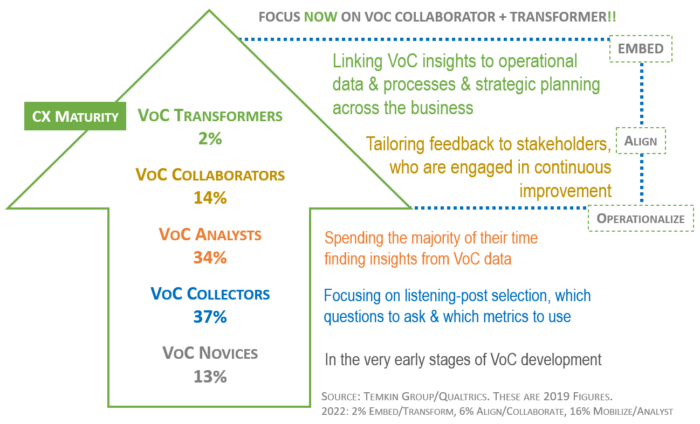
Synchronize the end-to-end CXM spectrum in your CX strategy. Start with the basics in every single building block. Emphasize flow. This will reduce dysfunction, silos, and costs. Most importantly, it will boost performance and clout. Imagine your company as an elite athlete: every muscle attuned to excel, muscle memory making excellence automatic, unrelenting focus to rise above any adversity, and thrilling accolades and opportunities abound.
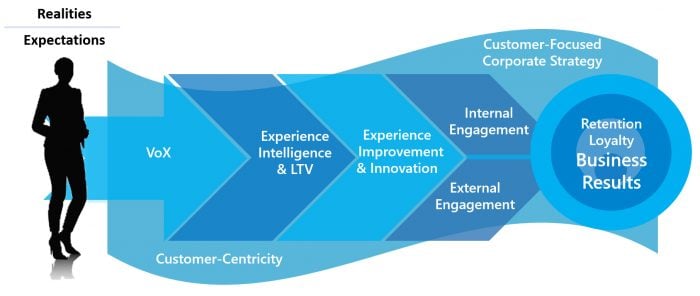
Reposition Your CCO Role for Everyone’s Prosperity
“Chief Officer” roles on the Senior Leadership Team influence enterprise-wide behaviors. For example, CHROs and CIOs require ALL supervisors to manage employee performance and data privacy. Years ago, HR and IT were Personnel Relations and Data Processing. That scope is severely insufficient for today’s realities. Likewise, narrow, remedial, and quick-win approaches for the Chief Customer Officer are severely insufficient for the post-pandemic needs of customers, employees, partners, and investors. Follow the precedent of HR and IT to establish your CCO role for full potential value.
By using the 24 CX ROI metrics as outlined here, you’ll rise above perpetual challenges with indisputable and indispensable value. Focus on the gold areas of CX-inspired growth, performance, strategies, and efficiencies, and your Chief Customer Officer role will make you the most valuable player as pivotal to greater success of every other Chief Officer.
Image licensed to ClearAction Continuum by Shutterstock.
This article is the fifth in a five-part series:
1. Chief Customer Officer Playbook: Balancing Experience Leadership with Experience Management
2. Chief Customer Officer Strategy: Redundant Playbook or Most Valuable Player?
3. 3 Ironic Success Factors for Your Chief Customer Officer Maturity Playbook
4. How to Thrill Investors with Your Chief Customer Officer Leadership Playbook
5. 24 CX ROI Metrics for Your Chief Customer Officer Prosperity Playbook



